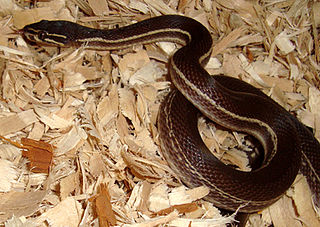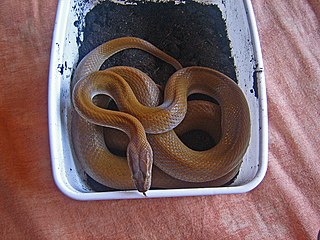
Gonyosoma oxycephalum, known commonly as the arboreal ratsnake, the red-tailed green rat snake, and the red-tailed racer, is a species of snake in the family Colubridae. The species is endemic to Southeast Asia.
Gonionotophis is a genus of snakes, known commonly as African ground snakes and file snakes, in the family Lamprophiidae. The genus is endemic to Central Africa.
Hormonotus is a genus of snakes. At present, this genus is monotypic, as there is only one commonly accepted species in it, Hormonotus modestus, commonly known as the Uganda house snake or yellow forest snake. It is widespread in tropical Africa. Its sister taxon is Inyoka swazicus, the Swazi rock snake.

Psammophis is a genus of snakes in the family Psammophiidae. The genus comprises 33 species, which are found in Africa and Asia. Psammophis are diurnal and prey on lizards and rodents which they actively hunt. All species in the genus are venomous, and the venom is considered mild and not dangerous to humans.

The broad-headed snake is a species of venomous snake in the family Elapidae. The species is restricted to the Sydney Basin in New South Wales, Australia. It is one of three snakes in the genus Hoplocephalus, all restricted to eastern Australia. It is currently endangered in New South Wales and is listed as vulnerable under the Commonwealth Legislation.

The Aurora house snake, Aurora snake, African house snake, or night snake is a non-venomous species of colubrid snake. It is endemic to Southern Africa.
Mehelya is a genus name of snakes native to Africa. Some species formerly assigned to the genus Mehelya are now found in the genera Gonionotophis, Gracililima, or Limaformosa. They are collectively called file snakes due to their unusual scalation. They are not venomous.

Lycodonomorphus is a genus of snakes commonly referred to as African water snakes. They are small, nonvenomous snakes, with all members being endemic to Africa, especially Tanzania.

The spotted house snake,, belongs to the monotypic genus Alopecion.

The Cape file snake is a species of large, non-venomous snake endemic to Africa, belonging to the family Lamprophiidae.

Boaedon is a genus of African lamprophiids consisting of the "brown" house snakes. The genus was originally described by Duméril but the species contained were reclassified as Lamprophis by Fitzinger in 1843, this taxonomy remained widely accepted until November 2010 when a phylogenetic study was published by C.M.R Kelly et al. who resurrected the Boaedon clade. Although commonly regarded as belonging to the Colubridae, primary literature usually lists them and related species as belonging to the family Lamprophiidae within the superfamily Elapoidea, which includes the venomous cobras and mambas.
Inyoka is a monotypic genus of southern African snakes. The word "inyoka" means "snake" in Zulu, Xhosa, Swahili, Shona and other African languages. These snakes were previously grouped in the genus Lamprophis but were found to be closer related to Hormonotus; a substantial genetic divergence between them and a 1900 km gap between their geographic ranges meant a new genus was erected for Lamprophis swazicus, the sole species of the new genus.

Boaedon lineatus, the striped house snake, is a species of lamprophiid from throughout Africa. This species has a wide range stretching from Tanzania through Central Africa as far as Uganda. They are kept as pets with increasing regularity, often captured and exported for the pet trade. Until November 2010, this species was grouped in the genus Lamprophis, but a paper published by Kelly et al. reclassified this species in the genus Boaedon.

Boaedon capensis, the Cape house snake, also known as the brown house snake, is a species of lamprophiid from Botswana, South Africa, Mozambique, Zambia and Zimbabwe. They are a non-venomous lamprophiid. This species was previously grouped in the genus Lamprophis but is regrouped with the genus Boaedon.

The Lamprophiidae are a family of snakes found throughout much of Africa, including Seychelles. There are 89 species as of July 2022.

Lamprophiinae is a subfamily of lamprophiid snakes, a large group of mostly African snakes, most of which were formerly classified as colubrids but which we now know are actually more closely related to elapids.

Lycodonomorphus inornatus, commonly known as the olive house snake, the black house snake, and the olive ground snake, is a species of nonvenomous snake in the family Lamprophiidae. The species is endemic to southern Africa. It is a nocturnal snake with terrestrial habits.

Bofa erlangeri, also known commonly as the Ethiopian house snake, is a species of snake in the family Lamprophiidae. The species is endemic to Ethiopia.












